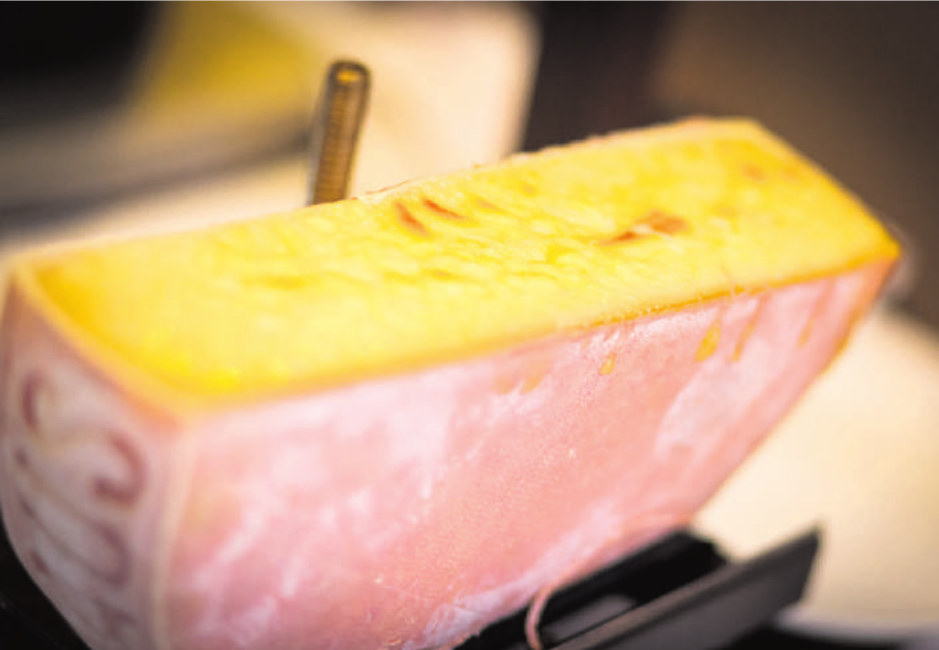Scraping away misconceptions
21.01.2022 Arts & Culture’Raclette’ comes from the French Valaisan verb racler, ‘to scrape’, which really says it all.
When I first came to the Saanenland in the early 1980s, many people told me that raclette cheese was from France. I was a bit surprised that the locals would hold foreign consumables in such high regard, but after I tasted it, I understood. No one in their right mind would care wherefrom something so delectable originated.
But of course the buttery, deliciously molten cheese treat is Swiss. It even has an appellation d’origine protégée (AOP) from our neighbouring canton of Valais (désolé, mes amis français). However, if this episode is indicative of my confusion surrounding things I’ve heard about the dish, it’s refreshing to know that other misconceptions abound.
Unterwalden, or the Valais?
According to the Kulinarisches Erbe der Schweiz, in the 12th and 13th centuries, a written tradition from the former Kloster Muri in Aargau mentions cheese melted over an open fire in the abbey’s mountain pastures in Unterwalden. If correct, this description of Bratkäse (fried cheese) precedes, by about 300 years, the first reference to the technique of melting cheese in the Valais, which occurs in 1574.
Many Swiss historians, such as Nicolas Morard, have noted that the cheeses of the Medieval period were not the rennet-coagulated, full fat, semi-hard cheeses like today’s raclette, and only date the use of rennet in the Alemannic areas of Switzerland to the 15th century. But whether these Bratkäse were bloomy-rind cheeses like France’s Brie de Meaux or Rougemont’s Tomme Fleurette, they were still melted, weren’t they?
Is Raclette a Fondue?
The celebrated Swiss chef Joseph Favre, in his 1895 work Dictionnaire universel de cuisine pratique, called raclette ‘Fondue à la valaisanne’ in Formule No. 1824. Since fondue in French means ‘melted’, this is a technically correct description, but as his other fondue recipes (e.g., à la vaudoise, à la genevoise) are all melted or prepared in a casserole, Favre was clearly aware that raclette was a different dish. This isn’t to say that Favre was confused about the nature of the cuisine, but no one today would call Raclette a ‘fondue’.
Deadly combinations?
I have often been told not to drink cold water or carbonated beverages when eating raclette because it can cause extreme intestinal distress, and possibly even be fatal. This is likely a variation of the Swiss urban legend that dyspepsia or death can result from consuming fondue with Coca-Cola. In an attempt to find the truth, a team of Swiss, German and British researchers conducted a study published in the Christmas 2010 British Medical Journal lyrically entitled, “Effect on gastric function and symptoms of drinking wine, black tea, or schnapps with a Swiss cheese fondue: randomized controlled crossover trial.”
Even though the article specifically examines fondue, the authors concluded that alcohol slows ‘gastric emptying’, and while people drinking tea took about six hours to start properly clearing their stomachs of cheese, those quaffing something stronger took closer to nine hours. Apparently, larger amounts of alcohol also led to a longer delay of the digestive process, so individuals with nighttime reflux or heartburn may want to reconsider that Steigbügel-Schluck (‘stirrup shot’) on the way out the door. Happily, healthy people can drink whatever they fancy with Switzerland’s sublimely cheesy repasts.
If, after reading this article, any misapprehensions still exist concerning raclette, I recommend one immediately make a reservation at your nearest Saanenland purveyor and indulge in some empirical investigation of this national treat. Ask plenty of questions, and don’t be surprised if you get some creative answers. And drink tea.
ALEX BERTEA




